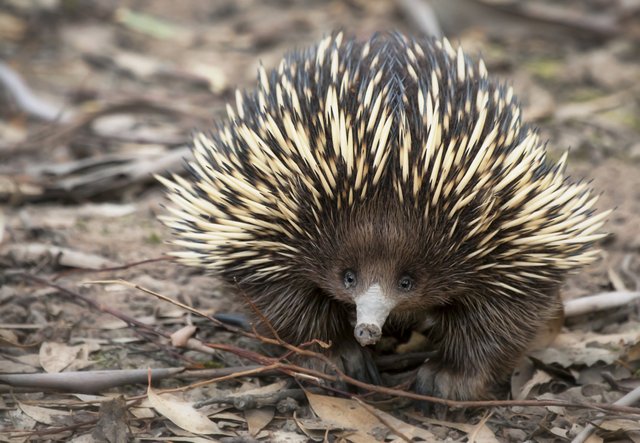How Echidnas survive wild fire.
Just yesterday my local government area suffered a tragic lost to fire and we were running in a confused and disorderly haste in search of refuge as our major market was caught up in fire, 4 persons dead, many more injured and millions of Naira were burnt.
See @arcjen02's post and video for more details.
Just then I began to think of the possibility of being able to survive fire burn and then my research drew my attention to an animal called Hedgehog.
We all know wildfire can tear through a large area of vegetative cover at terrifying speeds, incinerating almost everything in its path, turning it all to ash and leaving little more than blackened desert in its wake. This has created a natural, ingrained fear of fire in all animals including human and compels us all to flee the flames once sighted. But surprisingly this little creature (Echidna) has a rather crazy way for dealing with fire. It does nothing!
Now lets talk about Echidnas and fire.
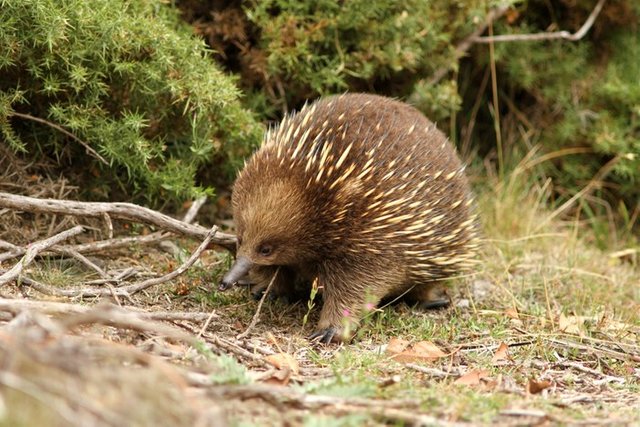
Photo Credit: JKMelville, via Wikimedia Commons
Echidnas belong to the family Tachyglossidae in the monotreme order of egg-laying mammals and are sometimes known as spiny anteaters. The echidna has spines like a porcupine, a beak like a bird, a pouch like a kangaroo, and lays eggs like a reptile. This mammals constantly diet on ants and termites though they sometimes eat worms and insect larvae. With their tongues having sharp and tiny spines, it helps them capture their prey easily. Having no teeth, Echidnas break down their food by grinding it between the bottoms of their mouths and their tongues.
Echidnas are found in forests and woodlands, hiding under vegetation, roots or piles of debris because they do not tolerate extreme temperatures; they use caves and rock crevices to shelter from harsh weather conditions. They sometimes use the burrows of animals such as rabbits and wombats.
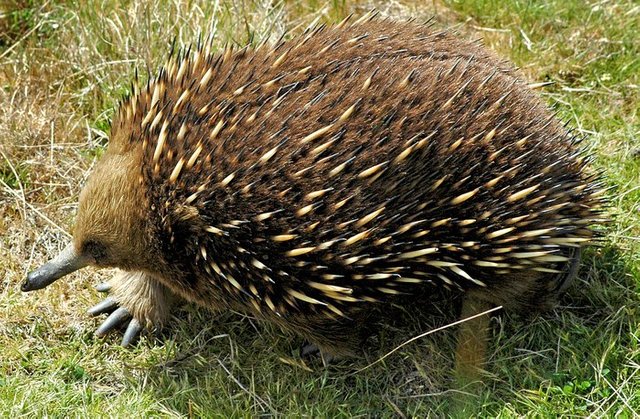
Photo Credit: I, KeresH, via Wikimedia Commons
What nifty adaptations did these ancient mammals have?
They survived the cataclysmic event that killed the dinosaurs.
Australian scientists say
it may be their ability to curl up and go into torpor.
According to the dictionary,
Torpor refers to a state of mental and motor inactivity with partial or total insensibility : extreme sluggishness or stagnation of function.
Another maybe its hollow hairs.
You can quickly distinguish a Echidna by its hollow hairs which are made stiff by keratin, these hairs are called spines
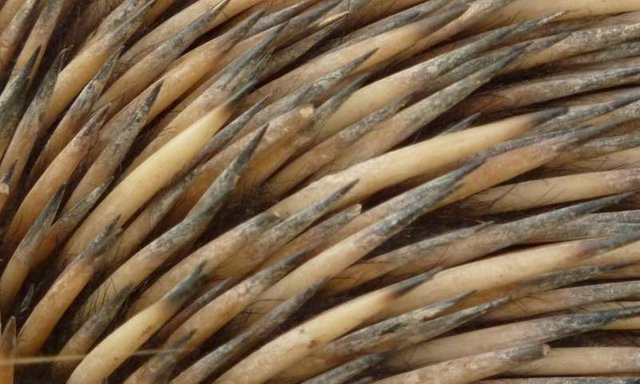
Spines and fur of an echidna.
Photo Credit: Vmenkov/Wikipedia
On April 21, 2015, The Department of Parks and Wildlife conducts prescribed burns to reduce the severity and extent of wildfires where it burned 227 hectares of Dryandra Woodland south-east of Perth. Comparing two groups of echidnas allowed biologists to study behaviour and fluctuations in body temperature of the echidnas before, during and after the burn.
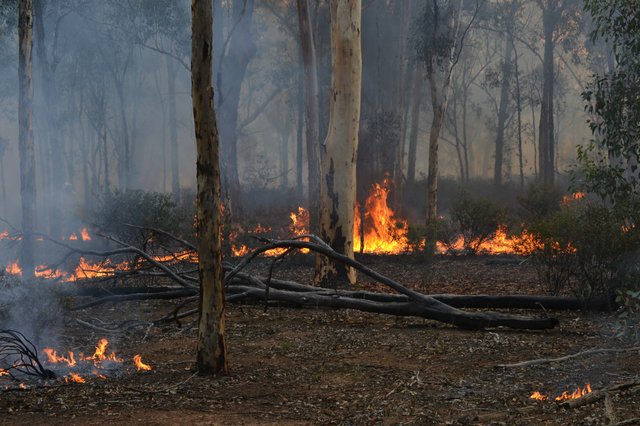
The controlled burn in progress.
Credit: Julia Nowack
To test the fire survival ability of these wonderful creatures, GPS trackers were placed on echidna’s in a nature preserve prior to setting the fire. The movement of the echidnas throughout the multi-day blaze and during the cooling-down period that followed was tracked and recorded.
When the fire was on, the Echidna woke up when they smelt smoke and took cover. During the most intense parts of the fire, it was discovered that the echidnas hid inside holes in logs and trees then entered torpor for up to four days at a time much longer than usual. After the fire, the researcher noticed the echidnas stayed in torpor states for many more days.
Despite the fact the fire was deadly to the rest of the mammal population living in the area, the study showed that echidnas can quickly lower their body temperatures to survive the fire and then enter torpor when food and water are scarce afterwards, thereby helping them avoid starvation. Torpor helps animals overcome the lack of food after a fire. When they emerge, they have to work hard, walking a greater area and looking harder. Although the echidnas in the burn area chilled out for up to five days, they are capable of lasting in this state of limbo for months.
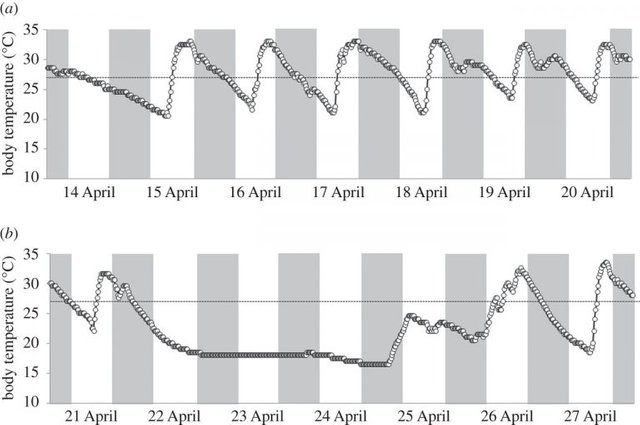
Chart showing body temperature measurements of of the same echidna (a) 7 days before and (b) 7 days after the fire.
Image Source
The fire survivors holed up during the day and restricted their activities even at night. Three went into torpor lasting as many as five days. With their metabolism running on low, the animals didn’t have to go out in search of food. The echidnas of the fire zone kept at this coping strategy not just for days but for at least three weeks after the fire. Unaffected echidnas, however, went about their normal routines.
Despite the scorched earth, none of the echidnas that lived in the burn area abandoned its territory. Not even the animals whose territories burnt completely felt the need to move. Instead, the prickly creatures merely decamped to unburnt logs. In another study, echidnas retreated to caves and burrows for long bouts of hibernation. They ducked into logs only during the hottest time of the day.
Photo Credit: Kristian Bell Via Shutterstock
The researchers suggest the response to fire by the echidnas might serve as a model for how some mammals managed to survive a strike by an ancient asteroid millions of years ago, wiping out the dinosaurs—by going in and out of torpid states allowing them to last a long time on very little nourishment.
We observed echidnas as one of very few survivors after the catastrophic bush fire at the Warrumbungles National Park in Eastern Australia in 2013. This made us realize that this species would be a good model to test the hypothesis that animals that have low energetic demands are coping better during and after catastrophic environmental events.
Dr. Julia Nowack from the University of New England also carried out a research work on these little creatures which was published in the Proceedings of the Royal Society B. You can read up here
